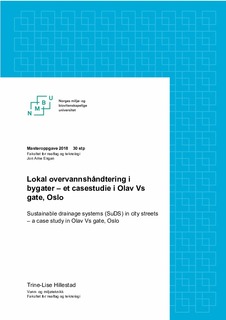| dc.contributor.advisor | Engan, Jon Arne | |
| dc.contributor.advisor | Åstebøl, Svein O. | |
| dc.contributor.author | Hillestad, Trine-Lise | |
| dc.coverage.spatial | Norway, Oslo | nb_NO |
| dc.date.accessioned | 2018-09-11T13:45:03Z | |
| dc.date.available | 2018-09-11T13:45:03Z | |
| dc.date.issued | 2018 | |
| dc.identifier.uri | http://hdl.handle.net/11250/2562090 | |
| dc.description.abstract | Som følge av klimaendringer er det forventet mer og intense nedbørshendelser som kombinert med økt urbanisering og andel tette flater i dagens byer, resulterer i økte mengder overvann. Konvensjonelt ledes overvannet direkte til sluk for videre transport i avløpsnettet, som i de fleste tilfeller er overbelastet. Resultatet er hyppigere overvannsflommer som medfører skade på miljø, helse, bebyggelse og infrastruktur. For å løse problemet har det i de senere årene vært et økt fokus rettet mot lokal overvannsdisponering (LOD) som et supplement til dagens rørsystem. LOD – tiltak skal håndtere overvannet lokalt og tilrettelegger for mer naturlige avrenningssystemer.
Det finnes lite litteratur på LOD-tiltak i bygater. Planlegging og dimensjonering er en kompleks og utfordrende prosess ettersom grunnforhold, eksisterende bebyggelse og infrastruktur begrenser tiltakets størrelse og teknisk oppbygning. Målet med oppgaven er å undersøke hvilke løsninger som er anvendelige i bygater med hensyn til vannets kvalitet og kvantitet. Utgangspunktet til vurderingen har derfor vært en caseoppgave fra Olav Vs gate. Gaten er en svært sentral bygate i Oslo sentrum med mye infrastruktur under overflaten. COWI AS, heretter omtalt som COWI, har på oppdrag fra Oslo kommune prosjektansvar for overvannshåndteringen, og ønsker å se på muligheten for hvordan og hvilke blå-grønne LODtiltak som kan samkoordineres med eksiterende infrastruktur og bebyggelse samt tilpasses de eksisterende grunnforhold. | nb_NO |
| dc.description.abstract | As a consequence of climate changes, more severe incidents caused by rain are expected. Combined with increased urbanisation, and the higher density of today’s cities, results in increased instances of flow exceeding sewer capacity. As a result of the increased frequency of sewage overflow, floods that cause damage to the environment, health, housing and infrastructure have become more prevalent. In an effort to solve the problem, in recent years there has been an increased focus on sustainable drainage systems (SuDS) as a supplement to today's water and sewerage systems. With SuDS, mitigating measures will be handled locally and facilitate a more natural drainage systems.
There is little literature on SuDS measures in urban areas within Norway, and planning and implementing is a complex and challenging process, as existing population, geographical restrictions, buildings and infrastructure can limit the size and type of solutions that are possible. The objective of this assignment is to investigate which solutions are more applicable to the urban areas, providing a high level of health security whilst achieving the lowest environmental impact. Comparing the quantity of sewerage water dealt with, and the resulting quality of the water passed through the system. This paper expands on the works carried out within the case «Olav Vs gate», which is a central street in Oslo city center with a lot of infrastructure underground. COWI AS, hereinafter referred to as COWI, has been awarded project management responsibility by the municipality of Oslo to investigate waste water management, looking at suitable SuDS measures that can be coordinated with existing infrastructure and housing. | nb_NO |
| dc.language.iso | nob | nb_NO |
| dc.publisher | Norwegian University of Life Sciences, Ås | nb_NO |
| dc.rights | Attribution-NonCommercial-NoDerivatives 4.0 Internasjonal | * |
| dc.rights.uri | http://creativecommons.org/licenses/by-nc-nd/4.0/deed.no | * |
| dc.subject | LOD | nb_NO |
| dc.subject | Overvannshåndtering | nb_NO |
| dc.subject | SuDS | nb_NO |
| dc.subject | Sustainable drainage systems | nb_NO |
| dc.subject | Regnbed | nb_NO |
| dc.title | Lokal overvannshåndtering i bygater : et casestudie i Olav Vs gate, Oslo | nb_NO |
| dc.title.alternative | Sustainable drainage systems (SuDS) in city streets : a case study in Olav Vs gate, Oslo | nb_NO |
| dc.type | Master thesis | nb_NO |
| dc.description.version | submittedVersion | nb_NO |
| dc.subject.nsi | VDP::Teknologi: 500::Bygningsfag: 530::Bygg-, anleggs- og transportteknologi: 532 | nb_NO |
| dc.source.pagenumber | 87 | nb_NO |
| dc.description.localcode | M-VM | nb_NO |

